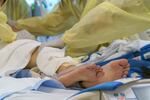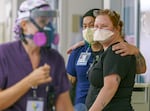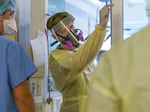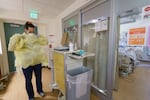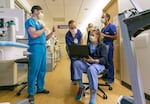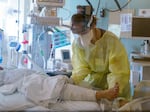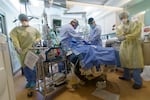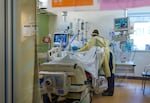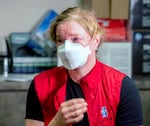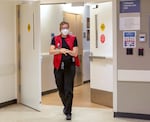In glass-walled rooms at Oregon Health & Science University Hospital’s medical intensive care unit, patients are sedated and on life support.
They are all here suffering from respiratory failure or other life-threatening complications of COVID-19. They are much younger than the people sickened by the coronavirus’ earlier waves — middle aged, or people still in their twenties or thirties.
Among the youngest in the unit is an unvaccinated dark-haired woman in her 20s. She is on a form of life support known as extracorporeal membrane oxygenation, or ECMO.
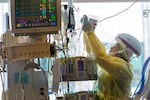
COVID-19 cases are surging across Oregon, and many hospitals are filled to capacity. At Oregon Health and Science University, Karla Mayorga, a registered nurse, tends to a patient in the intensive care unit in Portland on Aug. 19, 2021. Every person on this unit is critically ill with COVID-19.
Kristyna Wentz-Graff / OPB
Her lungs are too damaged to be inflated by a ventilator. Instead, she’s on something that’s like dialysis for the lungs. The ECMO machine pumps blood out through one large tube, infuses it with oxygen, and then returns the blood through a second tube for her heart to pump back into her body. Two stuffed animals are propped up on the window next to her bed.
“We have had people in their twenties die in this unit. We have had mothers lose their babies in this unit,” Erin Bonai, the charge nurse on duty, said on Thursday.
“People always think it can’t be them because they are fully functioning in their lives and that’s just not true. And the real truth is that we don’t know who is going to be impacted,” Bonai said. “We can’t look at five people on the street and say, oh that’s the one who would get critically ill. That’s just not how it works.”
About one of every three intensive care unit hospital patients has COVID-19 in Oregon. That’s 232 people statewide.
Many of the sickest have been transferred to OHSU, which invited OPB to see how the strain is affecting its hospital.
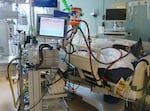
The most critical patients at OHSU are connected to an extracorporeal membrane oxygenation device, or ECMO, which removes blood from the patient, routed through an oxygenator unit, right. Then oxygen-rich blood is recirculated to the patient’s body.
Kristyna Wentz-Graff / OPB
OHSU has four intensive care units, including a 16-bed medical ICU that has been converted into a unit dedicated to COVID-19 patients. All four ICUs are completely full, so some patients who need intensive care been moved to other areas of the hospital.
Julie Kleese, one of the nurses, said OHSU is short on both staff and physical places to put the sickest patients.
The highly trained doctors and nurses working in this unit support smaller hospitals across the state, providing advice and accepting transfers from hospitals that can’t handle more complex patients.
Now there are no beds left — but the phone calls asking for help keep coming from rural Oregon hospitals.
“This patient is 26 and dying. This patient is 21 and dying. This patient is a father of four and dying. You know, can you help us? Our rural partners are struggling. They’re at the limit of their capabilities and that’s when they turn to us — and the inn is full,” Kleese said.
Many of the nurses and doctors who remain feel like they never had time to recover emotionally from the COVID-19 surge in the winter. And now it’s happening all over again.

Julie Kleese, RN, cries after sharing her experiences as an ICU nurse at OHSU Hospital in Portland, Ore., Aug. 18, 2021.
Hanin Najjar / OPB
Even before the COVID-19 pandemic, Oregon and the U.S. were facing a nursing shortage. With the additional stress of the pandemic, more nurses are burning out and leaving the profession altogether.
The doctors and nurses who remain on staff at OHSU use all the tools at their disposal to try to save each life — a demanding effort that often requires one nurse per patient.
Some simple but powerful interventions that can help a person’s lungs recover do not require costly equipment. Rolling patients onto their stomachs, a practice known as proning, can help the back of the lungs open up more, for example.
It sounds simple. But it can take four people working with a sling and a mechanical lift to do it, because it’s risky to move a patient who is on a breathing tube and ventilator.
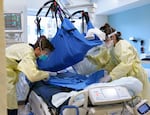
A patient is rolled onto their stomach. It helps the back of the lungs open up more. And pretty early on, there’s evidence that COVID-19 patients are less likely to die if they’re put on their stomachs periodically.
Kristyna Wentz-Graff / OPB
At many smaller hospitals, interventions like these aren’t an option. They just don’t have enough staff. So COVID-19 patients may be more likely to die because no one is available to move them onto their stomachs.
Related: Patient with COVID dies waiting for ICU bed in Roseburg
And health care workers expect it to get worse. OHSU is preparing to accept more COVID-19 patients next week. The hospital is taking steps toward what’s known as “crisis standards of care.” Nurses may be assigned more patients to care for, or people may be put in parts of the hospital that aren’t normally used for ICU patients.
Unvaccinated
All but one of the patients in OHSU’s COVID-19 intensive care unit last week were unvaccinated.
For the medical professionals trying to save their lives, that can be one of the hardest parts of working through this crisis: caring for people suffering and dying of a syndrome that has no cure, but that’s preventable with a vaccine.
Kleese said she primarily feels grief that her patients and their families are suffering unnecessarily.
“I think there can be misplaced anger for people who simply don’t have the right information,” she said.
“Sometimes they will say, ‘I was wrong, when can I get the vaccine?’ Sometimes they’ll deny it to their dying breath, and sometimes they don’t get to ever know what their outcome is because they die too soon.”
Their work is exhausting. Frustrating. Sad. Overwhelming. And endless.
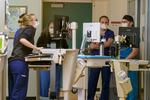
During rounds, medical teams at OHSU work together to strategize individual patient care on Aug. 19, 2021. At a time when hospital crews are stretched thin by efforts to respond to COVID-19, nurses say camaraderie keeps them going.
Kristyna Wentz-Graff / OPB
Each nurse said camaraderie and a sense of supporting each other is what keeps them showing up day after day.
But that won’t stop the pandemic or keep people from dying of COVID-19 in their ICU. More people getting vaccinated and wearing masks is the only way out.
“Ten years down the road, I think I’ll be really proud of the nurse I was these couple of years,” said Kristen Roach, who picked up an extra shift to help her colleagues this week. “I think we need to think about our future selves and how we would look back on this moment. And to feel like you did everything you could to limit the transmission of delta would be something that you could feel really proud of.”
Kristyna Wentz-Graff contributed to this story.




























